
The "Arts and Crafts" movement was a reaction to the disappointment that many artists had with the nature of machine made goods. These artists believed that machine created products lacked quality and artistic merit and demeaned the soul. The "Arts and Crafts" practitioners elevated their concerns to a moral level and developed an extensive philosophy about the superiority of "hand made" goods. This philosophy is also known by other names such as Craftsmanship and extended beyond silver or spoons to comprise homes (Wright), Furniture (Stickley), Decorative items (Tiffany, Faberge) etc.
Most of the arts and crafts silver output is in the art deco style which is much plainer than the earlier art nuevo and various Victorian styles, but the A and C craftsmen also looked at historical styles for inspiration.
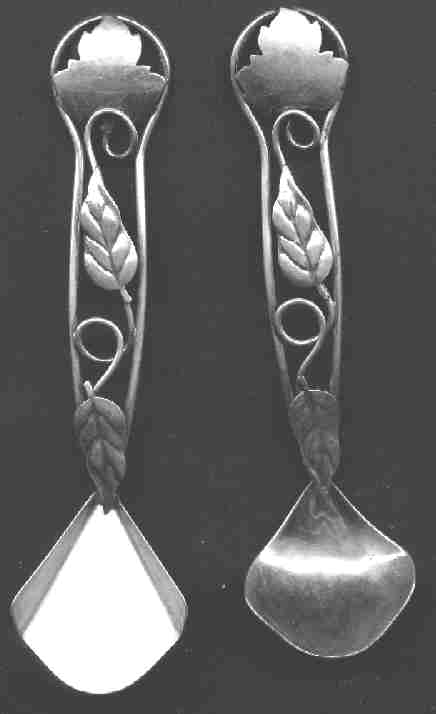
Matched set of very unusual Arts and Crafts spoons
These spoons are marked, but I have been unable to trace the maker.
In our day it is hard to imagine that one would spend an extensive amount of time creating a spoon, but the artists of this style did precisely that. They literally hand hammered a spoon from a piece of raw silver in the old style and forced the metal to conform to their vision. These are one-of-a-kind pieces that were meant to uplift the soul and to last an entire lifetime. The shapes are often much plainer than those found in the Art Nuevo movement and in some cases are more simple than the later Art Deco movement which was inspired, in part, by these dedicated craftsmen. In some cases they deliberately left their hammer marks to show that the spoon was hand-hammered. (Note: some manufacturers quickly picked up on this style and developed automatic hammering machines.). There are subtle differences between the real arts and crafts hand hammered style and the machine produced look-alikes. It is possible to develop your "eye" to see these differences.
Note the hammer marks on these distinctively made spoons by Shreve Silversmiths, San Francisco, which are made in the rare 14th century pattern. The finials on each piece are purposely different.
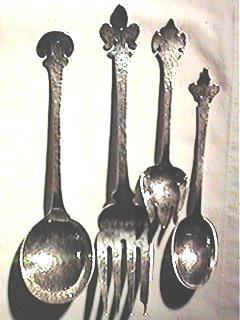
In Denmark the leading proponent of this artistic style was the Jensen silversmithing firm. This curved handled spoon is an excellent example of their quality of workmanship.
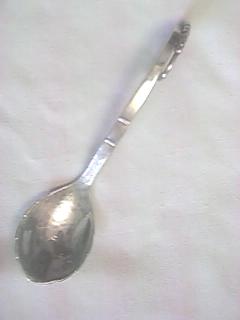
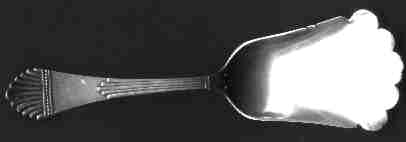
This Art's and Craft's caddy (sugar scoop) spoon is very similar to the Jensen style, but the mark does not match the ones in my book. It may be Jensen or another silversmith imitating his style
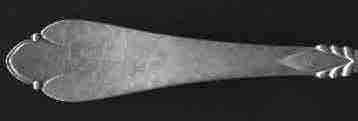
Large serving spoon (7" 180mm) made in the Art's and Crafts Style from Copenhagen. The styling is similar to Jensen. The back is engraved "Tini" which is probably the recipient. There is a control mark of S. Groth (1863 - 1904) and was made by E. Schopflich
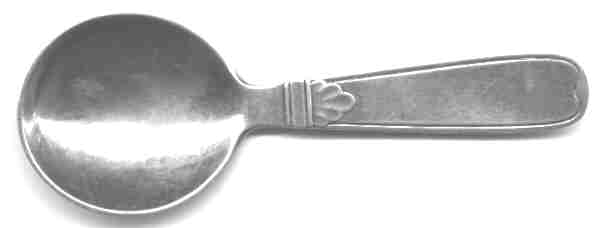
Caddy spoon from Copenhagen (1939) in imitation of the Jensen style

Arts and Crafts spoon from Copenhagen in the "trifid" style. The trifid spoons were produced in the 16th century and many A & C craftsmen drew inspiration from that time period. This spoon was made in 1930. Heisey control mark

This cute little fork has nice engraving reminiscent of the early 1890's on the deco style handle. The fork tines are also shaped in a "hollow" (spoon) manner. Made in Sweden by "MEMA"
The spoon below combines elements of art nuevo and arts and crafts in a very distinctive style. This beautiful spoon features a bronze horse head near the top, below is extensive art nuevo style engraving and connecting to the bowl is a typical art deco bead pattern. I suspect that this spoon was an "award" spoon for some horse related event.

One of the few American professional spoonmakers still actively practicing the Arts and Crafts style is Allan Adler of Los Angeles. Mr. Adler is very old now and produces only a few pieces for resale.
I have obtained this very cute "snowman" Childs spoon and fork set by Allan Adler. (note: one reader believes that these are rabbits-- I can see what she is saying but they look like snowmen to me.)
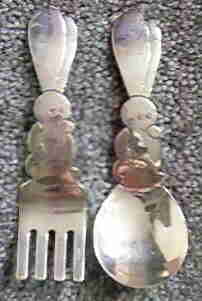
Several other examples of Adler's work may be seen by clicking here
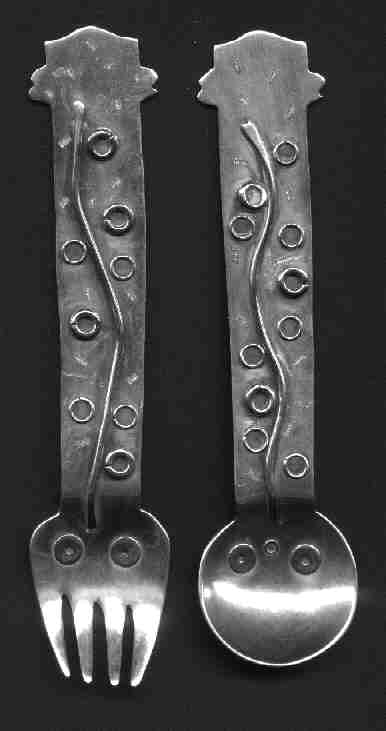
This very "strange" hand made sterling spoon and fork set is engraved on back as being from the "cheerio man", Walt V. Buster and dated 1989

Interesting Shovel bowl Arts and Crafts spoon from Quebec. You can't see the subtle hand hammering in the photo, but the actual piece is much nicer than the picture. I was also intrigued by the shoulders which are commonly found in fiddle pattern spoons from the 19th century (although in this case they are flared slightly). I suspect that this piece is from the very early part of the 20th century.

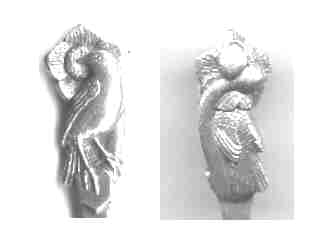
Very heavy arts and crafts tea sized spoon featuring a three dimensional bird at the finial. The second picture shows the front and back views. Made in London in 1938 by "SC"

This very heavy hand hammered tea size spoon features a sailboat at the finial. It bears London hallmarks for 1904 and was made by "JPC"
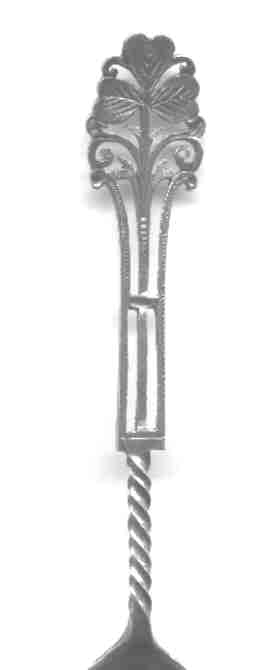
Arts and Crafts cutout design creating a triple shaft leading to a three
leaf finial. This demi spoon combines elements of
A & C as well as Gothic Renaissance to create a very interesting spoon.
The letters "CAXT" are engraved in the bowl in a most unusual style (not
shown - the bowl is very deep and the picture is hard to see). Made in Sheffield,
England, 1907.

I am unsure of the exact use of this hand hammered server by the New York firm of Wood and Hughes. The aesthetic styling of the bowl leads me to believe that it is probably from the 1880's, but it could have been as late as 1899 when the firm ceased business. It could have been designed as a sugar shovel, a bon bon shovel or ?
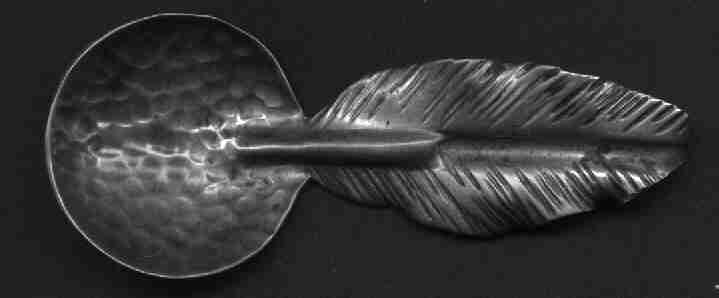
Very cute hand made copper spoon with a tobacco leaf handle. Arts and Crafts disciples often worked with materials other than silver. This spoon may have been designed as a "wine taster" as it has a small loop at the back where the leaf curls over. Another very similar piece has surfaced which indicates that it was "made in Rhodesia". So it is a rare African Arts and Crafts spoon

This simple, but elegant, spoon is typical of much of the arts and crafts
output.
Many of the spoons were not fancy or elaborate. They were purposely designed
to be functional and to be of high quality. This hand hammered piece is silver,
but I have been unable to trace the mark (not unusual)
I am not sure as to which category I should place this very unusual "owl" spoon.
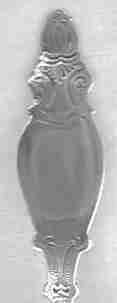

This coin silver handmade spoon features an unusual owl finial and an even more unusual narrow scalloped bowl which has a flower engraved on it. The stem (not shown) is twisty. I suspect that it dates from the 1880-1890 time period based upon styling.
The manufacturer mark is WSW MFG Co which I couldn't find in my books
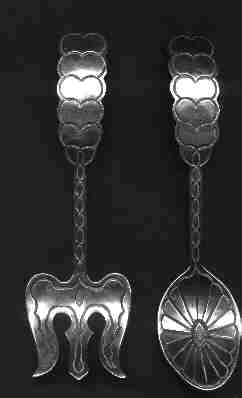
Very large (7.25" 185mm) and very very heavy (7.5 troy ounces) set was made by a silversmith who identified himself as k.y. I have not been able to further identify it yet. The handles seem to feature embedded hearts and the spoon bowl seems to be a stylized shell motif.

Interesting designed hand made sterling spoon, but there is no maker mark. The bowl has a hand hammered surface.

Unusual spoon from the Netherlands. Note the very strange bowl shape.
Marks indicate that it was made by "D.K." about 1938 from 833 silver

This rather plain looking spoon is a classic A&C Art Deco design. Solidly made in Germany of 900 silver with subtle hammer marks remaining, the only decoration is the engraved name of the owner "Wolfgang".

Georg Jensen spoon in a art deco moderne styling
Click to see an Arts & Crafts flatware set in Art Deco Moderne styling
Two other artistic styles were also in vogue around the turn of the century and souvenir spoons and silver flatware was also made in these styles.
More examples of Arts and Crafts spoon in the Gothic style are shown in the "Victorian Styles Index" under "Gothic" which you can reach from the main index.
Click to see examples of ART NUEVO.
Click to see examples of ART DECO.